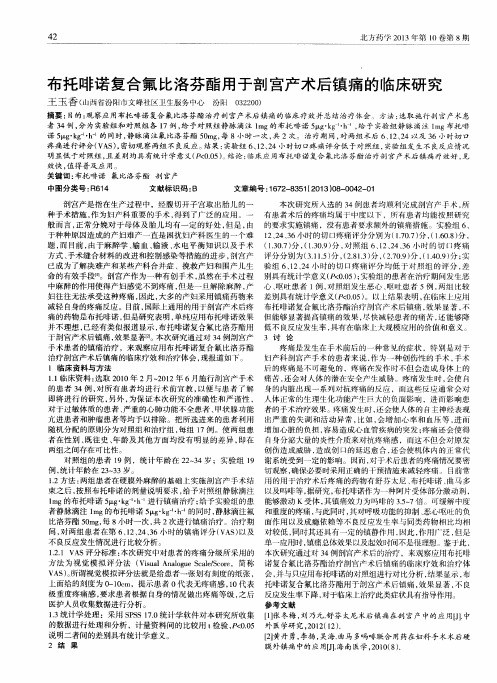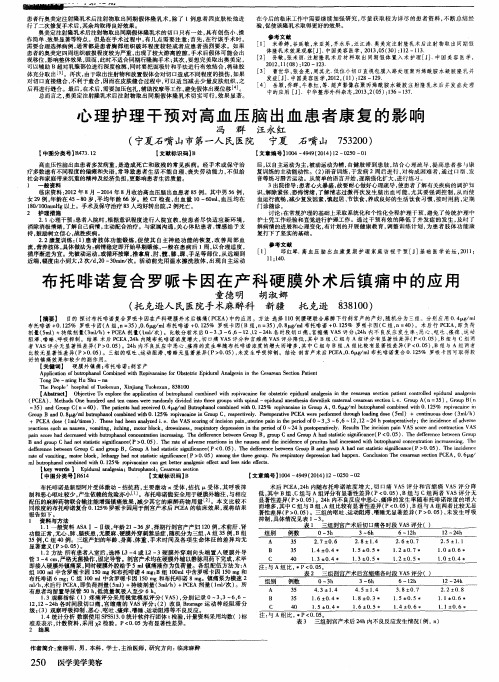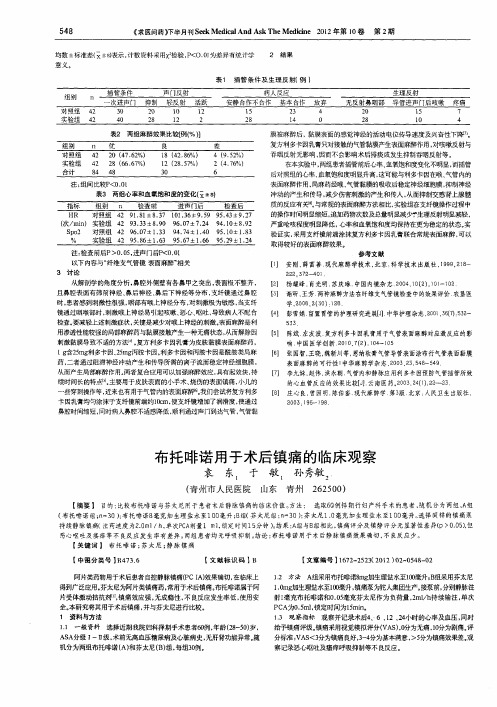布托啡诺复合甲哌卡因经TAP阻滞在剖宫产术后镇痛的临床观察
布托啡诺用于剖宫产术后镇痛临床研究

【 yw r s uop a o; n lei C sra et n Ke o d 】B trh n lA ags ; eaensci a o
剖 宫 产 术 后镇 痛 是临 床 产科 最 受 关 沣 的 问 题之 一 . 、日 前, 术后 镇 痛 常 用 的 方 式 为 患 者 自控 镇 痛 ( C , 脉 注 射 P A) 静 是 其 经 典 的 给 药 方 式 。 临 床 研 究 爪 , C 具 有 良 好 的 镇 痛 PA 疗 效 。 年来 , 片受体 激 动一 近 阿 拈抗 剂 布托啡 诺 被 广泛 应用 于 刮 宫 产 术 镇 痛 , 镇 痛 效 果 可 达 吗 啡 的 8俯 , 呼 吸 抑 制 其 而
22 8第 卷 2 0年 月 9第3 1 期
・ 麻醉与镇痛 ・
布托 啡诺用于剖 宫产 术后镇痛 临床研究
阮丁 异 朱文 涛 刘龙 清 连 志 鹏 福州 总 医院 第一 附 属 医院麻 醉 科 , 建莆 田 3 10 福 5 10 [ 摘要 】目的 探 讨 布托 啡 诺 在剖 宫 产术 后 患 者 自控 静脉 镇 痛 ( CA) 的应 用效 果 。 方 法 选 择 我 院 2 1 PI 中 0 0年 l 0月 ~ 21年 l 01 2月行 剖 宫产 术 的产 妇 2 0例 , 6 将其 随 机 分为 观察 组 与 对 照组 , 每组 各 10例 。观 察组 产 妇 给予 布托 啡 诺 3 进行 P I 对 照组 患 者 给 予芬 太尼进 行 P I C A, C A。在 剖 宫产 术后 4 8 1 、4及 3 、 、2 2 6h分 别记 录患 者 的疼 痛评 分 ( 用 疼 采 痛视 觉模 拟 评分 法 , AS 与镇 静评 分 ( 用 R msy法 ) 同 时观 察 患者术 后 并 发 症 的发 生情 况及 患者 满意 度情 况 。 V ) 采 a a ,
布托啡诺在剖宫产术后镇痛的效果评价

布托啡诺在剖宫产术后镇痛的效果评价
张文彪;陈彩云
【期刊名称】《吉林医学》
【年(卷),期】2012(033)023
【摘要】目的:评价布托啡诺在剖宫产术后镇痛的效果.方法:选择我院收治的足月妊娠选择剖宫产患者308例,随机分为观察组和对照组各154例,所有患者行2%利多卡因硬膜外麻醉,术后接镇痛泵,对照组药用 0.15%罗哌卡因加芬太尼4 μg/ml,观察组药用0.15%罗哌卡因加40 μg/ml 布托啡诺,持续背景输注 3 ml/h.结果:两组患者术后24 h内镇痛效果均满意,比较无统计学意义(P>0.05);观察组恶心呕吐、皮肤瘙痒发生率明显低于对照组,差异有统计学意义(P>0.05).结论:布托啡诺可为剖宫产术后提供安全有效的镇痛作用,且不良反应少.
【总页数】1页(P5010)
【作者】张文彪;陈彩云
【作者单位】山西省大同市南郊人民医院,山西,大同,037001;山西省大同市南郊人民医院,山西,大同,037001
【正文语种】中文
【相关文献】
1.布托啡诺在剖宫产术后镇痛的效果评价 [J], 张文彪;陈彩云
2.布托啡诺与布托啡诺复合舒芬在剖宫产术后镇痛中的效果比较 [J], 张扬;王大伟
3.不同浓度布托啡诺在妊娠合并子宫瘢痕剖宫产术后镇痛中的应用效果 [J], 陈永华; 叶丽娴; 王洁茹
4.布托啡诺复合甲哌卡因经TAP阻滞在剖宫产术后镇痛的临床观察 [J], 程小融;吴巧玲;王昊
5.右美托咪定复合布托啡诺用于剖宫产术后镇痛中的效果及对产妇泌乳情况的影响[J], 焦丽雯;华会波
因版权原因,仅展示原文概要,查看原文内容请购买。
布托啡诺复合氟比洛芬酯用于剖宫产术后镇痛的临床研究

北方药学 2 0 1 3年第 1 0卷第 8 期
布托 啡诺 复合氟 比洛芬酯 用于剖 宫产 术后镇痛 的临床 研究
土土杳 ( 山西省汾 『 文峰社区卫生服务中心 汾 0 3 2 2 0 0 )
摘要 : 目的: 观察应用布托啡诺复合 氟比洛芬 酯治疗剖 宫产术后 镇痛的临床疗效并 总结治疗体会 , 方法 : 选取施行剖 宫产术患 者3 4例 , 分为 实验组和对照组各 1 7例 , 给 予对照组静脉滴 注 l mg的布托 啡诺 5 1 . z g ・ k g 一 ・ h , 给予 实验组静脉滴注 1 m g布托 啡 诺5 t x g ・ k g ・ h 的 同时 , 静脉滴 注氟比洛 芬酯 5 0 m g , 每 8小 时一 次, 共 2次。治疗期 间, 对两组术后 6 、 1 2 、 2 4以及 3 6小时切 口 疼痛进行评分( V A S ) , 密切 观 察 两组 不 良反 应 。 结果 : 实验 组 6 、 1 2 、 2 4小 时切 口疼 痛 评 分 低 于对 照 组 , 实验 组 发 生 不 良反 应 情 况 明显低 于对照组 , 且差别均具有统计学意义( P < 0 . 0 5 ) 结论 : 临床应 用布托啡诺复合 氟比洛芬酯治疗剖宫产术后 镇痛 疗效好 , 见
效快 , 值得普及应 用
关键词 : 布托啡诺 氟比洛芬酯 剖宫产
中图 分 类 号 : R 6 1 4 文 献标 识 码 : B 文章编号 : 1 6 7 2 — 8 3 5 1 ( 2 0 1 3 ) 0 8 — 0 0 4 2 — 0 1 本次研究所入选 的 3 4例 患 者 均顺 利 完 成 刮 宫 产 }术 , 所 有患者术后 的疼痛均属 于中度 以下 ,所 有患者均能按照研 究 的要求实施 镇痛 ,没有患者要求额外的镇痛措施 。实验组 6 、 l 2 、 2 4 、 3 6小 时 的 切 口疼 痛评 分 分 别 为 ( 1 . 7 0 . 7 ) 分, ( 1 . 6 0 . 8 ) 分,
布托啡诺在妇产科手术后的镇痛应用观察

布托啡诺的用药剂量和给药方式对其镇痛效果和安全性具有重要影响 ,需要优化用药方案以提高治疗效果和安全性。
PART 07
结论与展望
REPORTING
研究结论总结
布托啡诺在妇产科手术后镇痛效果显 著,总有效率高。
布托啡诺不良反应发生率低,安全性 较高。
布托啡诺能够降低患者疼痛评分,改 善患者生活质量。
剂量调整策略
初始剂量
根据患者的体重和疼痛程度,给予适 当的初始剂量。
剂量调整时机
剂量的调整应根据患者的疼痛程度和 不良反应情况进行。通常需要在疼痛 评估后进行剂量调整。
追加剂量
如果初始剂量不能充分缓解疼痛,可 以根据需要给予追加剂量。但应注意 避免过量使用,以免出现不良反应。
注意事项与不良反应处理
01
注意事项
在使用布托啡诺前,应详细询问患者的过敏史和用药史,以确保安全使
用。同时,应遵循正确的用药方法,避免与其他药物混合使用。
02
不良反应监测
在使用布托啡诺期间,应密切监测患者的不良反应,如呼吸抑制、恶心
、呕吐、头晕等。
03
不良反应处理
一旦发现不良反应,应立即采取措施进行处理。对于严重的不良反应,
镇痛作用机制
作用于中枢神经系统(CNS)的 阿片受体,激活抗疼痛系统,产
生镇痛作用。
通过调节5-羟色胺(5-HT)的释 放和吸收,影响疼痛信号的传递
。
抑制前列腺素(PG)的合成,降 低炎症反应,从而减轻疼痛。
药效学特点
01
02
03
起效快
布托啡诺注射后迅速分布 至全身,快速达到有效血 药浓度。
镇痛效果好
布托啡诺在妇产科手 术后的镇痛应用观察
布托啡诺用于剖宫产术后镇痛临床研究

布托啡诺用于剖宫产术后镇痛临床研究目的探讨布托啡诺在剖宫产术后患者自控静脉镇痛(PCIA)中的应用效果。
方法选择我院2010年10月~2011年12月行剖宫产术的产妇260例,将其随机分为观察组与对照组,每组各130例。
观察组产妇给予布托啡诺进行PCIA,对照组患者给予芬太尼进行PCIA。
在剖宫产术后4、8、12、24及36 h 分别记录患者的疼痛评分(采用疼痛视觉模拟评分法,V AS)与镇静评分(采用Ramsay法),同时观察患者术后并发症的发生情况及患者满意度情况。
结果观察组与对照组患者在术后4、8、12、24及36 h各时间点疼痛评分比较,差异无统计学意义(P > 0.05),但观察组患者术后各时间点镇静评分明显高于对照组,差异有统计学意义(P 0.05). In the observation group at each time point after operation sedation score significantly higher than that of the control group, the difference was statistically significant (P 0.05),具有可比性。
1.2 麻醉方法所有产妇在手术前给予0.1 g鲁米那钠,0.3 mg东莨菪碱肌内注射。
手术麻醉方式为连续硬膜外麻醉,穿刺点为L1~2,选择3%氯普鲁卡因作为局部麻醉药。
剖宫产术后观察组给予负荷量为0.5 mg布托啡诺实施镇痛,对照组给予负荷量为0.05 mg芬太尼实施镇痛,两组患者均使用一次性PCA输液泵。
观察组与对照组的药物配方为,观察组:负荷量0.5 mg布托啡诺,10 mg阿扎司琼与0.25 mg/kg布托啡诺;对照组:负荷量0.05 mg芬太尼,10 mg阿扎司琼与20 μg/kg 芬太尼。
使用0.9%氯化钠溶液将药物稀释至100 mL,给予背景剂量2 mL/h,PCA 给药量为0.5~1.0 mL/次,锁定时间为20 min。
布托啡诺复合罗哌卡因用于剖宫产术后硬膜外镇痛的临床研究

布托啡诺复合罗哌卡因用于剖宫产术后硬膜外镇痛的临床研究【摘要】目的探讨布托啡诺复合罗哌卡因用于剖宫产术后硬膜外镇痛的临床疗效。
方法将86例剖宫产手术产妇随机分为研究组和对照组,对照组采用吗啡复合罗哌卡因镇痛,而研究组则采用布托啡诺复合罗哌卡因镇痛,并对两组产妇术后镇痛和镇静等评分情况进行比较分析。
结果研究组与对照组相比,产妇在术后8 h的镇痛评分显著提高,差异具有统计学意义(P<0.05),且其他各时段的镇痛评分情况亦有所提高(P>0.05);产妇在术后各时段的镇静评分均有所提高,但均未表现出统计学差异(P>0.05);产妇发生瘙痒、恶心、呕吐、嗜睡的比率均显著降低,差异具有统计学意义(P<0.05)。
结论布托啡诺复合罗哌卡因用于剖宫产术后硬膜外镇痛具有重要意义,值得进一步的推广和应用。
【关键词】布托啡诺;罗哌卡因;剖宫产剖宫产是目前妇产科临床上一种较为重要的手术助产方法[1],因此,为进一步提高剖宫产术后硬膜外镇痛效果,特对2010年3月至2011年6月期间在我院行剖宫产手术的产妇进行布托啡诺与罗哌卡因的复合镇痛,其临床治疗效果显著,现将结果报告如下。
1 资料与方法1.1 一般材料选择2010年3月至2011年6月期间在我院行剖宫产手术的产妇86例,年龄22~38岁,平均(24.53±3.18)岁;体重57~78 kg(平均61.46±5.32 kg);ASA分级均在Ⅰ~Ⅱ级。
所有产妇均经相关检查,于术前排除恶心和呕吐以及皮肤瘙痒史产妇,且无阿片类药物滥用史和相关药物过敏史。
随机为研究组和对照组,每组43例,两组产妇在年龄、体重、ASA分级等一般资料比较差异均无统计学意义(P>0.05),具有可比性。
1.2 研究方法两组产妇在手术前30 min肌内注射0.5 mg阿托品和0.1 g鲁米那钠,进入手术室后全面建立静脉通道,并对产妇的心电图(ECG)、心率(HR)、平均动脉压(MAP)、血氧饱和度(SpO2)等相关指标进行常规监测,所有产妇均行硬膜外麻醉,选择L2~3间隙穿刺成功后头向置管3 cm,使麻醉平面控制在T8以下。
布托啡诺复合格拉司琼用于剖宫产术后镇痛临床观察

布托啡诺复合格拉司琼用于剖宫产术后镇痛临床观察摘要】目的比较布托啡诺复合格拉司琼与芬太尼在剖产术后镇痛的临床意义。
方法选择产科行剖宫产手术产妇80例,随机分两组,A组布托啡诺+格拉司琼组40例,布拉啡诺10mg+格拉司琼3mg+生理盐水共100ml,B组:芬太尼组40例,芬太尼1.5mg+生理盐水共100ml。
两组均采用机械镇痛泵,背景剂量为2ml/h。
接泵前A组静注1mg布托啡诺为负荷量,B组静注0.05mg芬太尼为负荷量。
结果两组比较镇痛评分无统计学差异(P>0.05),镇静评分有统计学意义(P<0.05)。
眩晕、恶心、呕吐等不良反应的发生率有明显差异,有统计学意义。
【关键词】布托啡诺格拉司琼芬太尼剖宫产术后静脉镇痛近年来,阿片受体激动拮抗剂布托啡诺被广泛应用于剖宫产术后的镇痛。
阿片受体激动剂芬太尼是临床常用的镇痛剂,但芬太尼脂溶性差,可分布于全身各组织,可在其他器官产生不良反应[1]。
1 资料与方法1.1一般资料选择我院产科行剖宫产手术产妇80例,年龄:20—40岁,ASA分级I—II级,无肝肾功能异常。
随机分两组,A组:布托啡诺+格拉司琼组,B组:芬太尼组。
每组40例。
1.2方法 A组布托啡诺10mg+格拉司琼3mg+生理盐水共100ml。
B组芬太尼1.5mg+生理盐水共100ml。
接泵前A组静注布托啡诺1mg负荷量,B组静注芬太尼0.05mg负荷量,泵的背景剂量为2ml/h。
1.3观察指标观察并记录4、8、12、24h的镇痛效果、镇静效果及眩晕、恶心、呕吐等不良反应情况。
疼痛评分采用VAS法,无痛为0分,剧痛为10分。
镇静评分采用大Ramsay法,1分为清醒,2-4分镇静适宜,>4分镇静过度,5分在疼痛刺激下才有反应。
1.4统计学方法计量资料用均数±标准差表示,组间t检验,计数资料x2检验,P<0.05有统计学意义。
2 结果(1)镇痛效果:两组镇痛均满意,差异无统计学意义(P>0.05)。
布托啡诺镇痛作用在剖腹产术后的应用观察

THANK YOU
感谢聆听
在剖腹产术后镇痛中,布托啡诺可作为一种有效的镇痛药物选择,尤其适用于对呼吸循环功能要求较 高的患者。
在临床实践中,可根据患者的具体情况和疼痛程度,灵活调整布托啡诺的用药剂量和给药方式,以实现 个体化镇痛治疗。
未来可进一步探讨布托啡诺与其他镇痛药物的联合应用,以期在提高镇痛效果的同时,降低不良反应发 生率。
02
布托啡诺药物简介
药物成分及作用机制
主要成分
布托啡诺,一种合成的阿片类镇痛药。
作用机制
通过与中枢神经系统中的阿片受体结合,产生镇痛、镇静和镇咳作用。布托啡诺具有激动和拮抗双重 作用,对κ受体有完全激动作用,镇痛作用强;对μ受体有部分激动和部分拮抗作用,可减少恶心、呕 吐等副作用。
镇痛效果与安全性评价
布托啡诺镇痛作用在剖腹产术 后的应用观察
目
CONTENCT
录
• 引言 • 布托啡诺药物简介 • 剖腹产术后疼痛现状及影响因素 • 布托啡诺在剖腹产术后的应用方法
与剂量选择 • 疗效观察与评价指标 • 结果分析与讨论 • 结论与展望
01
引言
目的和背景
目的
探讨布托啡诺在剖腹产术后镇痛中的疗效和安全性。
镇痛效果
布托啡诺在剖腹产术后镇痛中表现出良好的镇痛效果,可显著减 轻产妇的疼痛感,提高产妇的舒适度和满意度。
安全性评价
布托啡诺在临床应用中表现出较高的安全性,不良反应发生率较 低。常见的不良反应包括恶心、呕吐、头晕等,但症状通常较轻 微,可自行缓解。
适应症与禁忌症分析
适应症
布托啡诺适用于剖腹产术后镇痛,也可 用于其他手术后的镇痛治疗。此外,还 可用于缓解中度至重度疼痛,如癌症疼 痛等。
布托啡诺在剖宫产术后镇痛中的应用效果研究

布托啡诺在剖宫产术后镇痛中的应用效果研究摘要】目的:分析布托啡诺在剖宫产患者术后镇痛中的应用效果。
方法:选取2019年1—6月四川省成都市新都区妇幼保健院收治的剖宫产322例作为研究对象,随机分为观察组(161例)和对照组(161例),行罗哌卡因加芬太尼治疗为对照组,行罗哌卡因加布托啡诺治疗的为观察组,对两组临床疗效进行分析。
结果:观察组的不良反应发生率明显低于对照组,差异显著(P<0.05);观察组不同时间点的VAS评分显著低于对照组,差异显著(P<0.05)。
结论:布托啡诺的使用,对于缓解剖宫产术后的疼痛感具有极大的帮助,其镇痛效果显著,降低术后镇痛的不良反应发生率,其临床应用价值显著。
【关键词】布托啡诺;剖宫产;术后镇痛;应用【中图分类号】R719 【文献标识码】A 【文章编号】2095-1752(2020)04-0072-02在临床医学方面,剖宫产术在妇产科中发挥着重要的作用,不仅可以解决难产问题,而且还可以给予胎儿生命安全强有力的保障。
相关数据表明[1],剖宫产发生率越来越高,但是剖宫产手术的创伤面较大,在术后,极容易产生疼痛反应,进而导致产妇身体应激反应的出现,产妇新陈代谢和细胞的耗氧量上涨非常迅速,这对产妇的康复产生了严重影响。
通过镇痛治疗的应用,可以对并发症的出现进行有效控制,并将产妇的生活质量提升。
1.资料与方法1.1 一般资料所有产妇均与剖宫产手术的指征相符,且均为初产者,尚未出现过敏史和麻醉类药物史。
将322例产妇随机分为观察组和对照组,各为161例。
最低年龄为20岁,最高年龄为35岁,平均年龄为(28.6±3.5)岁。
对比两组一般资料,其差异并不显著(P>0.05)。
1.2 方法首先,所有产妇在进入手术室之前,均对血压、心率、血氧饱和度等检测,在术前半个小时内,静脉滴注乳酸格林纳,其剂量为500ml,并对BP、HR等予以实时监测。
同时,于穿刺点L2/3采取腰硬联合麻醉,腰麻用药为0.5%布比卡因,其剂量最低为1.8ml,确保麻醉平面不超过T6。
布托啡诺复合罗哌卡因在产科硬膜外术后镇痛中的应用

在今后 的临床工作 中需要继 续加 强研究 , 尽 量获 取较为 详尽 的患者 资料 , 不 断总结 经
验, 促使该隆乳术取得更好的效果。
参 考 文献
[ 1 ] 米希婷 , 谷廷敏, 米 亚英, 齐永乐, 汪江涛. 奥美定注射隆乳术后注射物取 出同期假 体 隆乳术效果观察 [ J ] . 中国美容 医学, 2 0 1 3 , 0 5 ( 3 0 ) : l 1 2— 1 1 3 . [ 2 ] 孙敏 , 张米丽. 注射 隆乳术后材 料取 出同期假体 置入术 护理[ J ] . 中国编粤】 1 0 0 4— 4 9 4 9 l 2 0 1 4 ) 1 2— 0 2 5 0~ 0
后, 以自主运动为主 , 被动运动为辅 , 由健肢带到 患肢 , 结合 心理疏导 , 提 高患者参 1 康 复训练的主动能动性。( 2 ) 语音训练 , 于发病 2 周后 进行 , 对构 成困难 者, 通 过 口型、 发 音等练习唇舌运动。从简单的语言开始 , 逐渐强化扩大 , 进行练习。 3 出院指导 : 患 者心火暴盛 , 故要耐心做好心理疏导 , 使患者 r 解有关疾病 的调护 知 识. 解除 紧张、 恐怖情绪 , 了解情志过激再 次发生 脑 出血 可能 , 尤其要 强调控 制 , 从 而使 血运行流畅 , 减少复发因索 , 慎起居 、 节饮食 , 养成 良好的生活饮 食习惯 , 按时用药 , 定期 门诊随诊 。 讨论 : 在常规护理 的基础上采取 系统化和个性化全程 护理 干预 , 避免 了传统护理 中 护士凭工作经验和直觉进行护理工作 。通 过干预有 效 的降低了并 发症的 发生 , 及时 _ 『 解病情 的进展和心理变化 。 有计划 的开展健康 教育 , 调整 训练计划 , 为 患者肢体 功能 康 复打下 了坚实的基础 。
布托啡诺用于术后镇痛的临床观察

表3 两组心 率和血 氧饱和 度 的变化 ( ± ) s
冲动的产生和传导 , 减少伤害刺激的产生和传人, 从而抑制交感肾上腺髓 质的反应有关}与常规的表面麻醉方法相比, 8 】 。 实验组在支纤镜操作过程中 的操作时 间明显缩短 , 追加 药物次数及总 量明显减 少● 生理 反射 明显 减轻 , 严 重呛 咳程度 明显降 低 ,C-和血 氧饱和度 均保持 在更 为稳定 的状态 。 .  ̄- 实 验正实 , 采用支纤镜前端涂抹复方利多卡因乳膏联合常规表面麻醉 , 以 可 取得较好的表面麻醉效果。
tg 5  ̄多卡 因、5 g 含2mgf l l 2r 丙胺卡 因。 a 利多卡 因和 丙胺卡 因是酰胺 类局麻
【1 陈斌 左友 波 . 5 复方利 多卡 因乳膏用 于气 管表 面麻 醉对 应激反应 的 影 响 中国医学 创新 2 1,( )14 15 0 72 :0 - 0 0
止痛作用是吗啡的8 ~lo I 0 o倒 目前仍是静脉镇痛最常用的药物。 , 由于其 同时可刺激 第四脑 室底部 化学受 体触发带 (T )兴 奋延髓 呕吐 中枢 , 可 c Z, 故 引起恶心 、 呕吐l 布托 啡诺 及其主 要代 谢产 物激 动 K阿片 受体 , “受体 3 】 。 对 有激动、 拮抗双重作用 , 它主要与中枢神经系统中的这些受体相互作用间
【】 江明性 药理学 人民卫生出版社 .99 j4 4 1 18 :3 -l0 【] 柳俊杰. 2 赵俊. 现代麻醉学[】2 北京: M.版. 人民卫生出版社,973 8 J9 :}.
I W th ,n e PFPsoeai asaadvmt gieioy 副 acaM Fw j o lr r fue n o ii : st l t tD t el n t og
布托啡诺复合罗哌卡因用于剖宫产术后硬膜外镇痛的观察与护理

布托啡诺复合罗哌卡因用于剖宫产术后硬膜外镇痛的观察与护理诸 英,沈陆华,冯 彦(浙江省绍兴市妇幼保健院绍兴312000)摘要:目的 观察布托啡诺复合罗哌卡因用于剖宫产术后硬膜外自控镇痛的效果、不良反应,并进行相应的护理。
方法 80例剖宫产术产妇随机分为两组,每组40例。
观察组术后给予布托啡诺6mg 复合罗哌卡因400mg 行硬膜外自控镇痛,对照组给予布托啡诺8m g 复合枸橼酸芬太尼0 4mg 行自控静脉镇痛。
以视觉模拟评分法(VAS )评估术后镇痛效果,记录产妇满意度、副反应,予护理干预。
结果 两组产妇术后各时间段VAS 评分观察组显著高于对照组(P <0 05)。
观察组产妇发生瘙痒、恶心、呕吐、头晕、嗜睡的比率均显著降低(P <0 05),产妇镇痛满意率明显升高(P <0 05)。
结论 布托啡诺复合罗哌卡因用于剖宫产术后的硬膜外自控镇痛安全有效,不良反应发生率低。
通过护理干预可促进术后康复。
关键词:布托啡诺;罗哌卡因;硬膜外镇痛;护理中图分类号:R969 4 文献标识码:B 文章编号:1006-3765(2012)-12-0253-02作者简介:诸 英,女(1973 6-)。
毕业于温州医学院。
职称:副主任护师。
从事妇产科护理工作。
联系电话:013989507978,E -mail:zyfby312000@126 com剖宫产是产科常用的助产手术,术后疼痛引起的心理应激反应,常常会影响手术预后,增加产妇痛苦,使局部器官功能恢复迟缓。
在临床工作中,疼痛已成为继体温、脉搏、呼吸、血压四大生命体征之后的第五生命体征 1,日益得到重视。
控制术后疼痛,提高产妇舒适度,促进康复,选择一种有效安全的镇痛方法成为产科医护工作的重要服务内容。
本文对2011年10月至2012年2月在我院行剖宫产手术用布托啡诺复合罗哌卡因硬膜外镇痛的产妇,进行临床效果观察及护理,现将结果报告如下。
1 资料与方法1 1 临床资料 选择2011年10月至2012年2月在我院行择期剖宫产的产妇80例,孕周为37~41周,年龄22~38岁,体重56~81kg,ASA 分级均在 ~ 级。
观察布托啡诺复合舒芬太尼用于剖宫产术后镇痛的效果

观察布托啡诺复合舒芬太尼用于剖宫产术后镇痛的效果朱雄文【摘要】目的探析布托啡诺复合舒芬太尼用于剖宫产术后镇痛的效果.方法 200例行剖宫产手术的产妇作为研究对象,采用随机分配的原则分为观察组和对照组,各100例.两组产妇麻醉诱导和术中麻醉药物相同,术后镇痛中观察组采用布托啡诺+舒芬太尼+托烷司琼进行镇痛,对照组采用布托啡诺+托烷司琼进行镇痛,对两组的镇痛效果及安全性进行比较.结果两组产妇术后1、3、12、24、48 h视觉模拟评分方法的(VAS)评分比较差异无统计学意义(P>0.05);观察组产妇术后各时间点的Ramsay镇静评分明显优于对照组,差异具有统计学意义(P<0.05);观察组的不良反应发生率5.0%明显低于对照组20.0%,差异具有统计学意义(P<0.05).结论在剖宫产术后镇痛中使用布托啡诺复合舒芬太尼可改善产妇的疼痛症状,镇痛效果更佳,镇静适度,提升睡眠质量,且镇痛安全性高,值得推广和应用.【期刊名称】《中国现代药物应用》【年(卷),期】2018(012)009【总页数】2页(P130-131)【关键词】布托啡诺;舒芬太尼;剖宫产;术后镇痛;效果【作者】朱雄文【作者单位】517000 广东河源市妇幼保健院【正文语种】中文近年来,我国剖宫产率逐年递增,虽然剖宫产手术的成功率越来越高,但产妇术后疼痛却普遍疼痛,疼痛会导致产妇出现应激反应,对其术后身体康复和心理健康均造成一定程度的影响,临床上控制产妇疼痛尤为重要。
布托啡诺、舒芬太尼两种药物均可单独用于剖宫产术后镇痛,但以常规推荐剂量进行镇痛效果不佳,若加大用药剂量则会增加不良反应发生率[1, 2]。
鉴于此,本次研究选取200例行剖宫产手术的产妇为研究对象,对布托啡诺复合舒芬太尼用于剖宫产术后镇痛的效果进行评价,现报告如下。
1 资料与方法1.1 一般资料选取2017年1月~2017年8月200例于本院行剖宫产手术的产妇为研究对象,采用随机分配的原则分为观察组和对照组,各100例。
纳布啡复合布托啡诺、罗派卡因用于剖腹产术后镇痛的效果研究

指标
切口痛 VAS
宫缩痛 VAS
Ramsay 镇静
实验组 对照组 实验组 对照组 实验组 对照组
术后 4h
0.5依0.3 0.6依0.4 0.4依0.2 0.4依0.3 2.4依0.4 1.8依0.2
术后 8h 术后 12h 术后 24h 术后 48h
1.5依0.6 1.7依0.7 1.8依0.5 2.6依0.8 2.3依0.3 1.7依0.2
情况,同时根据 VAS 视觉模拟评分法和 Ramsay 镇静评分对两组术后 4h、8h、12h、24h 以及 48h 疼痛程度以及镇痛效果进行评分。 结果:实验组麻醉起效时间和痛觉消失时间明显小于对照组,麻醉维持时间明显高于对照组,差异均具有统计学意义(P约0.05)。两 组术后 4h、8h、12h、24h 以及 48h 切口痛 VAS 评分比较没有明显差异(P跃0.05),术后 8h、12h、24h 以及 48h 宫缩痛 VAS 评分比较 差异具有统计学意义(P约0.05),术后 4h、8h、12h、24h 以及 48h 后 Ramsay 镇静评分比较差异具有统计学意义(P约0.05)。两组不良反 应发生情况比较没有明显差异(P跃0.05)。结论:纳布啡复合罗哌卡因及酒石酸布托啡诺在剖宫产术后镇痛中效果显著,值得推广。 关键词:纳布啡 罗哌卡因 酒石酸布托啡诺 镇痛效果
北方药学 2019 年第 16 卷第 12 期
115
纳布啡复合布托啡诺、罗派卡因用于剖腹产术后镇痛的效果研究
周冠同 刘丹贤 何 莉 周 珊 林 丹 陆金桃 陆翠群(广东省英德市妇幼保健院计划生育服务中心
英德 513000)
摘要:目的:通过对比罗哌卡因复合酒石酸布托啡诺、纳布啡复合罗哌卡因及酒石酸布托啡诺在剖宫产术后镇痛中的效果,深度剖
布托啡诺复合甲磺酸罗哌卡因用于剖宫产术后硬膜外镇痛的效果

布托啡诺复合甲磺酸罗哌卡因用于剖宫产术后硬膜外镇痛的效果目的观察不同剂量酒石酸布托啡诺复合甲磺酸罗哌卡因用于剖宫产术后硬膜外自控镇痛的临床效果。
方法75例要求术后硬膜外镇痛治疗的剖宫产产妇,按布托啡诺用量不同随机分为三组。
A组:0.238%甲磺酸罗哌卡因+0.03mg/ml 布托啡诺;B组:0.238%甲磺酸罗哌卡因+0.04mg/ml布托啡诺;C组:0.238%甲磺酸罗哌卡因+0.05mg/ml布托啡诺,硬膜外自控镇痛,输注速率3ml/h。
观察切口疼痛评分、宫缩痛评分、肛门排气时间和不良反应。
结果C组切口疼痛评分低于A组,C组术后8h切口痛评分低于B组,C组宫缩痛评分低于A、B两组;A组辅助镇痛例数高于B、C两组,三组均无明显不良反应。
结论布托啡诺0.05mg/ml联合0.238%甲磺酸罗哌卡因对剖宫产患者行PCEA可提供满意的镇痛效果,且无明显不良反应。
标签:布托啡诺;甲磺酸罗哌卡因;硬膜外镇痛酒石酸布托啡诺是一种阿片受体激动拮抗剂,主要激动κ受体而产生镇痛作用,布托啡诺复合布比卡因或盐酸罗哌卡因用于术后镇痛临床已有报道[1,2]。
本研究观察不同剂量的布托啡诺复合甲磺酸罗哌卡因用于剖宫产术后硬膜外镇痛的临床效果。
1资料与方法1.1一般资料75例要求行PCEA的剖宫产产妇,ASAⅠ~Ⅱ级,年龄20~35岁,身高150~168cm,体重58~82kg,术前各项检查正常,随机分为A、B、C三组,每组25例。
1.2麻醉方法所有患者均未用术前药,入室后常规监测ECG、BP、HR、RR、SpO2,开放外周静脉。
各组均采用腰硬联合麻醉,取左侧卧位,于L3~4或L2~3间隙穿刺,穿刺成功后经针内针向蛛网膜下腔注入等比重布比卡因8~10mg (0.75%布比卡因2ml和脑脊液1ml或生理盐水1ml混合液,根据产妇情况注入1.6~2.0ml),向头端置入硬膜外导管后平卧,经硬膜外导管注入2%利多卡因3ml 试验量,麻醉平面控制在T6~T8以下,手术体位采用左倾10~15°,所有產妇术中均面罩给氧,术中收缩压低于90mmHg或平均动脉压低于基础值的30%,加快输液并静脉注射麻黄素5~10mg,心率下降至50次/min以下时静脉注射阿托品0.2~0.3mg。
布托啡诺和吗啡复合甲磺酸罗哌卡因在剖宫产术后硬膜外镇痛的应用比较

布托啡诺和吗啡复合甲磺酸罗哌卡因在剖宫产术后硬膜外镇痛
的应用比较
黄杰锋
【期刊名称】《齐齐哈尔医学院学报》
【年(卷),期】2011(032)015
【摘要】目的比较布托啡诺和吗啡复合甲磺酸罗哌卡因在剖宫产术后硬膜外镇痛的效果.方法选择90例足月孕妇(ASA均Ⅰ~Ⅱ级)随机分为两组,布托啡诺组(A 组)45例,吗啡组(B组)45例,A组应用镇痛液甲磺酸罗哌卡因200 nmg加布托啡诺7mg的混合液100ml,B组应用镇痛液甲磺酸罗哌卡因200mg加吗啡5 mg的混合液100ml,两组镇痛液均采用持续自控给药模式,对两组镇痛效果及不良反应进行比较.结果两组均能取得良好的镇痛效果,无显著差异,但不良反应的发生率A组明显低于B组,P<0.05,有显著差异.结论布托啡诺应用于术后镇痛的效果与吗啡相当,但明显减少了不良反应的发生.
【总页数】1页(P2456)
【作者】黄杰锋
【作者单位】江苏省南通市第二人民医院 226002
【正文语种】中文
【相关文献】
1.芬太尼复合罗哌卡因与布托啡诺复合罗哌卡因对剖宫产术后硬膜外镇痛效果比较[J], 华林;王亚军
2.罗哌卡因复合布托啡诺、吗啡对剖宫产术后硬膜外镇痛的比较 [J], 戴岳
3.布托啡诺复合甲磺酸罗哌卡因用于剖宫产术后硬膜外镇痛的效果 [J], 吴世茫;韦善敏;覃金生;莫保众
4.芬太尼复合罗哌卡因与布托啡诺复合罗哌卡因对剖宫产术后硬膜外镇痛效果比较[J], 华林;王亚军
5.芬太尼复合罗哌卡因与布托啡诺复合罗哌卡因对剖宫产术后硬膜外镇痛的效果比较 [J], 张福清;聂海贵;吴恩慧;魏斌
因版权原因,仅展示原文概要,查看原文内容请购买。
- 1、下载文档前请自行甄别文档内容的完整性,平台不提供额外的编辑、内容补充、找答案等附加服务。
- 2、"仅部分预览"的文档,不可在线预览部分如存在完整性等问题,可反馈申请退款(可完整预览的文档不适用该条件!)。
- 3、如文档侵犯您的权益,请联系客服反馈,我们会尽快为您处理(人工客服工作时间:9:00-18:30)。
布托啡诺复合甲哌卡因经TAP阻滞在剖宫产术后镇痛的临床观察作者:程小融吴巧玲王昊来源:《中国医学创新》2021年第16期【摘要】目的:探讨布托啡诺复合甲哌卡因经腹横肌平面阻滞在剖宫产术后镇痛中的有效性和安全性。
方法:选择2019年1-12月90例拟于单次蛛网膜下腔阻滞下行剖宫产手术的患者,按随机数字表法随机分为对照组(C组)、布托啡诺1组(B1组)、布托啡诺2组(B2组),每组30例。
三组均在手术结束即刻实施超声引导下双侧腹横肌平面阻滞。
C组给予甲哌卡因+右美托咪定;B1组在C组基础上给予4 mg布托啡诺;B2组在C组基础上给予8 mg 布托啡诺。
比较三组术后2、4、8、12、24 h的静息和活动疼痛视觉模拟评分(visual analogue scale,VAS)及Ramsay镇静评分;比较三组术后24 h内补救镇痛、恶心、呕吐发生率、术后镇痛满意度、术后首次下床时间和术后至出院时间。
结果:B1、B2组产妇术后2、4、8、12 h静息和活动VAS评分均低于C组,差异均有统计学意义(P<0.05);术后24 h,三组产妇静息和活动VAS评分比较,差异均无统计学意义(P>0.05)。
B1、B2组产妇术后2、4、8、12 h Ramsay镇静评分均高于C组,且B2组高于B1组,差异均有统计学意义(P<0.05);术后24 h 三组产妇Ramsay镇静评分比较,差异均无统计学意义(P>0.05)。
三组产妇术后首次下床时间及术后至出院时间比较,差异均无统計学意义(P>0.05)。
B1、B2组术后补救镇痛率低于C组(P<0.05);B2组术后恶心、呕吐发生率高于C组、B1组,差异均有统计学意义(P<0.05);B1组术后镇痛满意度高于C组、B2组,差异均有统计学意义(P<0.05)。
结论:布托啡诺复合甲哌卡因经腹横肌平面阻滞用于剖宫产术后镇痛效果良好,且布托啡诺的合理应用剂量为4 mg。
【关键词】布托啡诺甲哌卡因右美托咪定腹横肌平面阻滞剖宫产Clinical Observation of Analgesic Effect of Butorphanol Combined with Mepivacaine for Transverse Abdominal Plane Block after Cesarean Section/CHENG Xiaorong, WU Qiaoling,WANG Hao. //Medical Innovation of China, 2021, 18(16): 0-070[Abstract] Objective: To investigate the efficacy and safety of Butorphanol combined with Mepivacaine for transversus abdominal plane block of analgesia after cesarean section. Method: A total of 90 patients underwent caesarean section under single subarachnoid block from January to December were selected, they were divided into control group (group C), Butorphanol group 1 (group B1) and Butorphanol group 2 (group B2) according to random number table method,30 patients in each group. Group C was given Mepivacaine + Dexmedetomidine; Group B1 was given4 mg Butorphanol in addition to group C; Group B2 was given 8 mg Butorphanol in addition to groupC. Resting and active pain visual analogue scale (VAS) and Ramsay sedation scores at 2, 4,8, 12, and 24 h after surgery were compared among three groups. The incidence of remedial analgesia, nausea and vomiting, total satisfaction with postoperative analgesia were compared among three groups within 24 h after surgery, and the time of first getting out of bed after surgery and postoperative to discharge time were compared among three groups. Result: The resting and active pain VAS scores of groups B1 and B2 at 2, 4, 8 and 12 h after surgery were lower than those of group C, with statistical significance (P<0.05). At 24 h after surgery, there were no statistical significances in resting and active VAS scores among three groups (P>0.05). Ramsay sedation scores at 2, 4, 8 and 12 h after surgery of groups B1 and B2 were higher than those of group C, and those of group B2 were higher than those of group B1, the differences were statistically significant (P<0.05). There were no significant differences in Ramsay sedation scores among three groups 24 h after surgery (P>0.05). There were no significant differences in the time of first getting out of bed after surgery and the postoperative to discharge time among three groups (P>0.05). The remedial analgesia rate of groups B1 and B2 were lower than that of group C(P<0.05). The incidences of postoperative nausea and vomiting of group B2 were higher than those of group C and group B1, with statistical significance (P<0.05). The total satisfaction of groupB1 was higher than that of group C and group B2, with statistical significance (P<0.05). Conclusion: The analgesic effect of Butorphanol combined with Mepivacaine for transverse abdominal plane block after cesarean section is fine, and the reasonable dosage of Butorphanol is 4 mg.[Key words] Butorphanol Mepivacaine Dexmedetomidine Transversus abdominal plane block Cesarean sectionFirst-author’s address: The First Affiliated Hospital of Jinzhou Medical University, Jinzhou 121001, Chinadoi:10.3969/j.issn.1674-4985.2021.16.016剖宫产术至今仍然是一些合并骨盆狭窄、头盆不称以及严重妊娠合并症产妇的首选分娩方式,但剖宫产术切口所致的腹壁痛及子宫收缩引起的内脏痛仍是影响患者对术后疼痛管理满意度的重要影响因素。
超声引导下的经腹横肌平面(transversus abdominis plane,TAP)阻滞经过大量的临床实践证实,对于下腹部手术患者的术后镇痛效果较好、加速患者术后康复[1-2]。
布托啡诺是一种脂溶性的阿片受体激动-拮抗剂,对三类阿片受体κ、μ、δ的亲和力为25︰4︰1,对κ受体的高度选择性使其对迷走神经支配的内脏器官具有良好的镇痛作用,即可有效地缓解内脏痛[3]。
Syracuse[4]的一篇关于布托啡诺在人类围生期的分布的文章表明:布托啡诺经产妇乳汁分泌极少,经母乳喂养对新生儿几乎无影响。
甲哌卡因是一种酰胺类局麻药,其起效快、作用较持久、安全用药剂量范围大,可用于硬膜外阻滞和区域神经阻滞[5]。
目前临床多采用PCIA行剖宫产术后镇痛,经静脉用药会增加嗜睡、呼吸抑制等不良反应。
因此,如何实现剖宫产术后镇痛模式的优化、如何在达到有效镇痛的同时降低不良反应发生率,对产妇术后早期恢复及早期哺乳具有重要意义。
目前,尚未见布托啡诺复合局麻药经TAP阻滞用于剖宫产术后镇痛。
本研究的目的在于探讨布托啡诺复合甲哌卡因经TAP阻滞在剖宫产术后镇痛中的有效性及探究布托啡诺的合理用药量,为临床麻醉工作提供参考。
1 资料与方法1.1 一般资料选择2019年1-12月90例在本院行剖宫产术的产妇。
